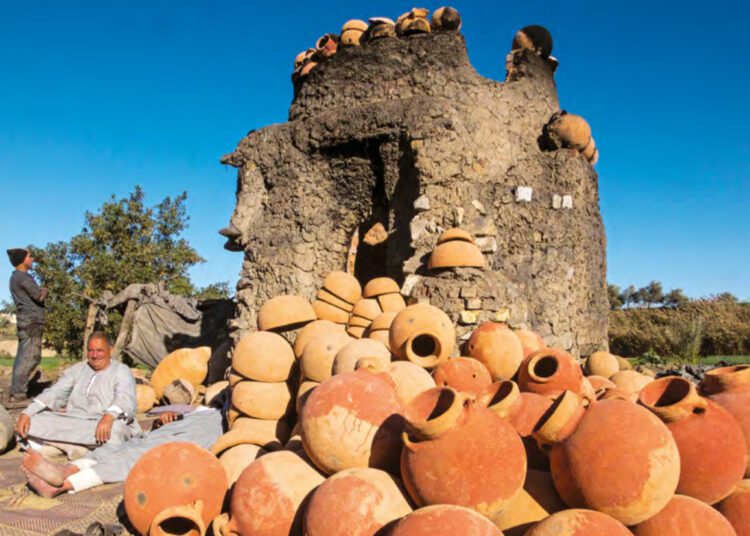With over 150 full-colour photographs of unique designs and rare methods of pottery making in Egypt, a new book titled “Fayoum Pottery Ceramic Arts And Crafts In An Egyptian Oasis” is providing an in-depth look at the pottery produced in Fayoum.
In the book, which is published by the AUC Press, author R. Neil Hewison depicts with photographs Fayoum City – a broad, fertile basin in Egypt’s Western Desert, which not only known for its great salt lake, its rich green fields, and its unique pharaonic and Greco-Roman remains, but also home to three very different centers of pottery production.
In one of the book contents, the author features potters of Kom Oshim who are specialise in decorated garden pots and other utilitarian ware, and guard the special secret of how to make the largest clay vessels in Egypt, up to an extraordinary two and a half meters tall.

“The pots are made of a blended mix of Aswan clay and ordinary Nile mud taken from any of the water channels in the area. The Nile mud adds the extra strength and solidity needed for the large, sturdy pieces produced at Kom Oshim, allowing the potters to build up the height of their garden pots to as much as an astonishing two and a half meters, the limit apparently set only by the size of the kilns,” the author said in his book.
In another chapter titled “al-Nazla”, the author features how the ancient traditions of pottery making are kept alive, as members of a single extended family continue to use millennia-old techniques passed down from generation to generation, hand-forming among other things their distinctive spherical water jars with amazing dexterity and speed.
In the chapter “Tunis”, he give a wide view of the small village of Tunis in Fayoum and the establishment of a pottery school by a Swiss couple in 1990 led to a complete transformation. The village now hosts more than twenty-five pottery workshops and showrooms, whose products are sold in Cairo, London, and New York. The book offers a number of colourful photos of the village and the pottery shops.

Also, in this lively insight into a varied and vital craft, the author reveals the stories of the three villages (Kom Oshim, Al-Nazla and Tunis) and the skilled potters who make their living there, looking at how they learned their trade and how they work, from the preparation of the clay to the formation of the pots on the wheel or by hand, to the decoration, the glazing, and the firing, and finally to the display or distribution and sale of the finished product.
Author R. Neil Hewison is the author of The Fayoum: History and Guide (AUC Press, revised edition 2008) and the translator of After the Nobel Prize 1989–1994: The Non-Fiction Writing of Naguib Mahfouz Volume IV (2020), as well as fiction by Yusuf Idris, Yusuf Abu Rayya, and Gamal al-Ghitani. He lives in the pottery village of Tunis in the Fayoum.




